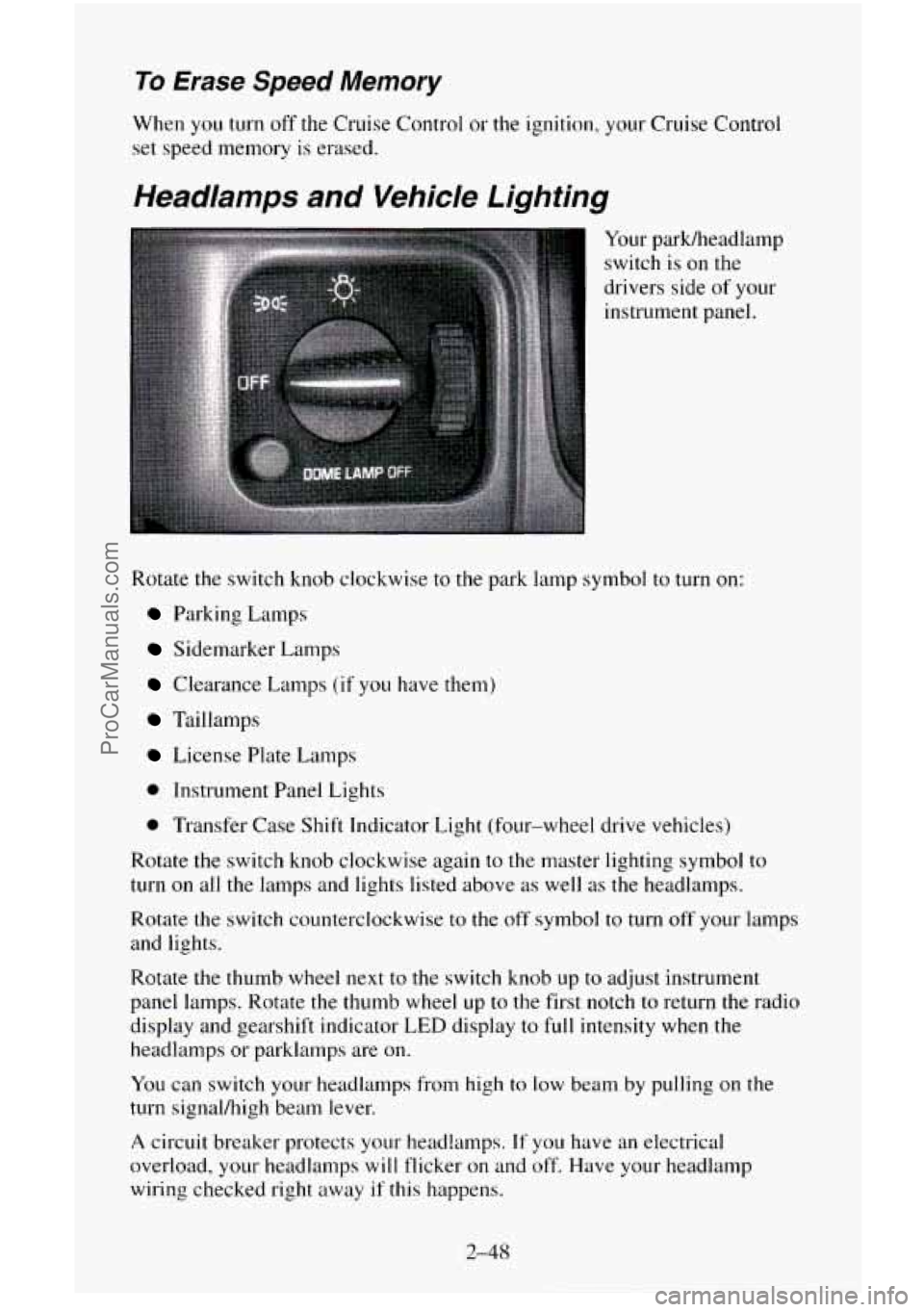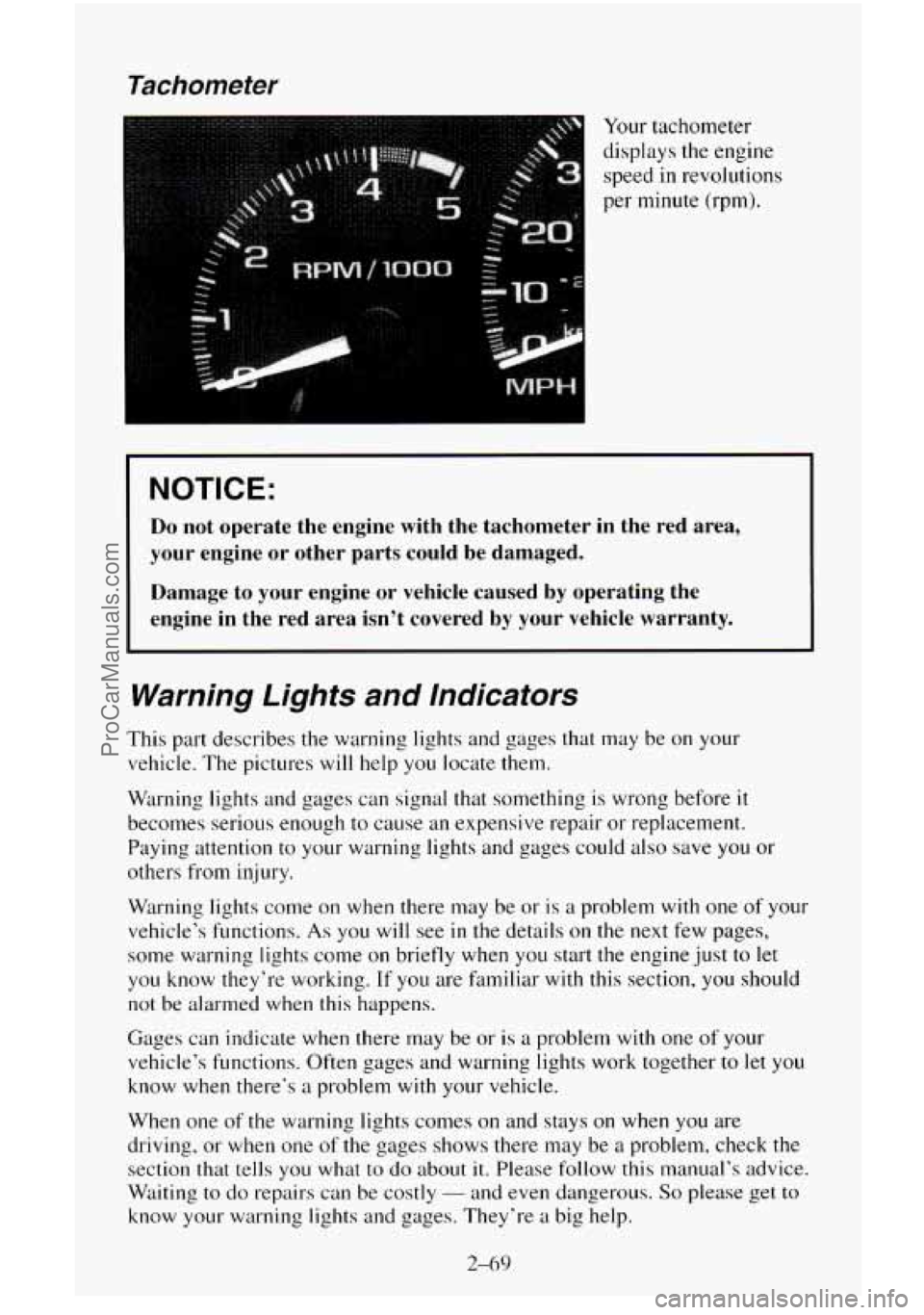Page 12 of 486
These symbols are important for you and your passengers whenever your
vehicle
is driven:
Fasten Safety Door LocWUnlock
Belts
These symbols have to do with your lights:
Master Lighting
Switch
-
Turn Signal Direction Hazard Warning
Flasher
Fog Lights Daytime
Running Lights
Vii
Headlight
High Beam
ProCarManuals.com
Page 13 of 486
These symbols are on some of your controls:
I
Windshield
Wiper Windshield
Washer
Rear Wlndow Washer
I
Rear Window
Defroster
w
I
Windshield
Defroster
U
Ventilating Fan
These symbols are used on warning and indicator lights:
I -k 4cccy
Engine Coolant
Temperature
BRAKE
I Brake
I I
Battery Charging
System
ANTI-
I LOCK
I I 4 Wheel
Anti-Lock
Fuel
Parking Brake Release
I\J
Rear Window
Wiper
Engine Oil
Pressure
SHIFT
Shift Light
viii
. ~ .. ProCarManuals.com
Page 115 of 486

To Erase Speed Memory
When you turn off the Cruise Control or the ignition, your Cruise Control
set speed memory
is erased.
Headamps and Vehicle Lighting
Your parWheadlamp
switch
is on the
drivers side
of your
instrument panel.
Rotate
the switch knob clockwise to the park lamp symbol to turn on:
Parking Lamps
Sidemarker Lamps
Clearance Lamps (if you have them}
Taillamps
License Plate Lamps
0 Instrument Panel Lights
0 Transfer Case Shift Indicator Light (four-wheel drive vehicles)
Rotate
the switch knob clockwise again to the master lighting symbol to
turn on all the lamps and lights listed above as well as the headlamps.
Rotate the switch counterclockwise to the off sylnbol to turn
off your lamps
and lights.
Rotate the thumb wheel
next to the switch knob up to adjust instrument
panel lamps. Rotate the thumb wheel up to the first notch to return
the radio
display and gearshift indicator LED display
to full intensity when the
headlamps or parklamps are on.
You can switch your headlamps from high to low beam by pulling on the
turn signal/high beam lever.
A circuit breaker protects your headlamps. If you have an electrical
overload, your headlamps
will flicker on and off. Have your headlamp
wiring checked right away
if this happens.
2-48
ProCarManuals.com
Page 119 of 486
Mirrors
Inside Mirror
Push or pull the tab
under the mirror to
reduce glare from
headlamps behind you
after dark.
Electrochromic lnside Rearview Mirror with Compass
(Option)
Your vehicle may have an optional electrochromic inside rearview mirror.
An electrochromic inside rearview mirror, when on, automatically dims to
the proper level to minimize glare from lights behind you after dark.
The mirror also includes an eight point compass display
in the upper right
corner of
the mirror face. When on, the compass automatically calibrates as
the vehicle is driven.
To use the electrochromic mirror only, move the switch at the bottom of the
mirror
to the M position. To use the electrochromic mirror as well as the
compass, move the switch to the
C/M position. To turn both features off,
move the switch to
the OFF position.
ProCarManuals.com
Page 123 of 486
Rear Window Wiper and Washer
Some visors have
mirrors with lights. If
the mirror has lights,
they will come on
when
you lift the
mirror cover.
The rear window wipedwasher switch
is on your instrument
panel, to
the passenger
side
of the gage
cluster.
To turn the wiper
on, slide the switch all the way up.
For delay wiping, slide the switch even with
DELAY in the center position
of the rear wiper control. The wiper will cycle every nine seconds.
To wash the window, push in on the switch. Window washer fluid will
continue to spray until the switch is released. The wiper will continue with
three more wipes and then return
to the setting that was chosen before the
lever was pushed.
The rear window washer uses
the same fluid bottle as the front windshield
washer.
If the fluid level is low in the washer fluid bottle, you may not be
able to wash your rear window.
If you can wash your windshield, but not
your rear window, check the fluid level.
2-56
ProCarManuals.com
Page 136 of 486

Tachometer
Your tachometer
displays the engine
speed in revolutions
per minute (rpm).
I NOTICE:
Do not operate the engine with the tachometer in the red area,
your engine or other parts could be damaged.
Damage to your engine
or vehicle caused by operating the
engine in the red area isn’t covered
by your vehicle warranty.
Warning Lights and Indicators
This part describes the warning lights and gages that may be on your
vehicle. The pictures will help
you locate them.
Warning lights and gages
can signal that something is wrong before it
becomes serious enough to cause an expensive repair or replacement.
Paying attention
to your warning lights and gages could also save you or
others from injury.
Warning lights come on when there may be or is a problem with
one of your
vehicle’s functions.
As you will see in the details on the next few pages,
some warning lights come
on briefly when you start the engine just to let
you know they’re working. If you are familiar with this section, you should
not be alarmed when
this happens.
Gages can indicate when there may be
or is a problem with one of your
vehicle’s functions. Often gages and warning lights work together
to let you
know when there’s a problem with your vehicle.
When one
of the warning lights comes on and stays on when you are
driving, or when one of the gages shows there may be a problem, check the
section that tells
you what to do about it. Please follow this manual’s advice.
Waiting
to do repairs can be costly - and even dangerous. So please get to
know your warning lights and gages. They‘re a big help.
2-69
ProCarManuals.com
Page 145 of 486
Turn Signal and Lane Change lndicator Lights
The green signal indicator will come on whenever you signal a turn or lane
change. See
“Turn Signal and Lane Change Indicator’‘ earlier in this section.
Gages
Fuel Gage
Gasoline Engine Diesel Engine
The fuel gage, when the ignition is on, tells you about how much fuel YOLI
have left in your tank. The gage will first indicate empty before you are out
of fuel,
and you should get more fuel as soon as possible.
Listed are
four situations you may experience with your fuel ea tracre:
At the gas station, the fuel pump shuts off before the gage reads ~LIII.
2-78
ProCarManuals.com
Page 193 of 486

0
0
0
0
0
0
0
Do not get too close to the vehicle you want to pass while you’re
awaiting an opportunity. For
one thing, following too closely reduces
your area of
vision, especially if you’re following a larger vehicle.
Also,
you won’t have adequate space if the vehicle ahead suddenly
slows or stops. Keep back a reasonable distance.
When it looks like
a chance to pass is coming up, start to accelerate but
stay in the right lane and don’t get too close. Time your move
so you
will be increasing speed as the time comes to move into the other lane.
If the way
is clear to pass, you will have a “running start” that more
than makes up for the distance
you would lose by dropping back. And
if something happens to cause you to cancel your pass, you need only
slow down and drop back again and wait for another opportunity.
If other cars are lined up
to pass a slow vehicle, wait your turn. But
take care that someone isn’t trying to pass
you as you pull out to pass
the slow vehicle. Remember
to glance over your shoulder and check
the blind spot.
Check your mirrors, glance over your shoulder, and start your left lane
change signal before moving
out of the right lane to pass. When you
are far enough ahead
of the passed vehicle to see its front in your inside
mirror, activate your right lane change signal and move back
into the
right lane. (Remember that if your right outside mirror is convex, the
vehicle
you just passed may seem to be farther away from you than it
really is.)
Try not to pass more
than one vehicle at a time on two-lane roads.
Reconsider before passing
the next vehicle.
Don’t overtake a slowly moving vehicle
too rapidly. Even though the
brake lights are not flashing, it may be slowing down or starting to turn.
If you’re being passed, make it easy for the following driver to get
ahead of
you. Perhaps you can ease a little to the right.
Loss of Control
Let’s review what driving experts say about what happens when the three
control systems (brakes, steering and acceleration) don’t have enough
friction where
the tires meet the road to do what the driver has asked.
In any emergency, don’t give up. Keep trying
to steer and constantly seek an
escape route or area of less danger.
Skidding
In a skid, a driver can lose control of the vehicle. Defensive drivers avoid
most skids by taking reasonable care suited
to existing conditions, and by
not “overdriving” those conditions. But skids are always possible.
4-10
ProCarManuals.com